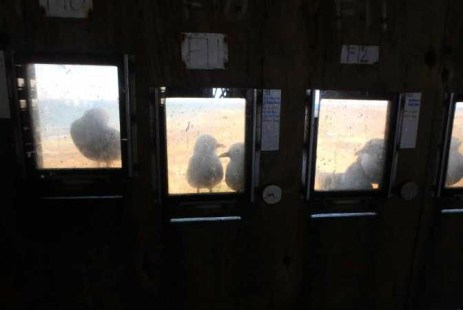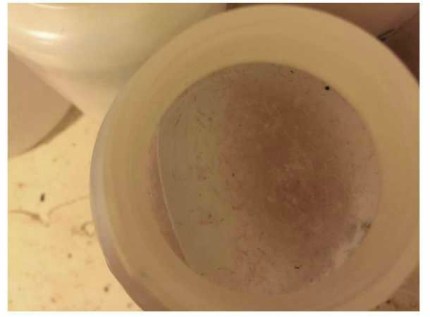NOAA Teacher at Sea
Cara Nelson
Aboard USFWS R/V Tiglax
September 11-25, 2019
Mission: Northern Gulf of Alaska Long-Term Ecological Research project
Geographic Area of Cruise: Northern Gulf of Alaska – currently sheltering in Kodiak harbor again
Date: September 23, 2019
Weather Data from the Bridge:
Time: 13:30
Latitude: 57º47.214’ N
Longitude: 152º24.150’ E
Wind: Northwest 8 knots
Air Temperature: 11ºC (51ºF)
Air Pressure: 993 millibars
Overcast, light rain
Science and Technology Log
As we near the end of our trip, I want to focus on a topic that it is the heart of the LTER study: zooplankton. Zooplankton are probably the most underappreciated part of the ocean, always taking second stage to the conspicuous vertebrates that capture people’s attention. I would argue however, that these animals deserve our highest recognition. These small ocean drifters many of which take part in the world’s largest animal migration each day. This migration is a vertical migration from the ocean depths, where they spend their days in the darkness avoiding predators, to the surface at night, where they feed on phytoplankton (plant plankton). Among the zooplankton, the humble copepod, the “oar-footed,” “insect of the sea,” makes up 80% of the animal mass in the water column. These copepods act as a conduit of energy in the food chain, from primary producers all the way up to the seabirds and marine mammals.
Aboard the R/V Tiglax, zooplankton and copepods are collected in a variety of manners. During the day, a CalVet plankton net is used to collect plankton in the top 100 meters of the water column.
On the night shift, we alternated between a Bongo net and a Multinet depending on our sampling location. The Bongo net is lowered to 200 meters of depth (or 5 meters above the bottom depending on depth) and is towed back to the surface at a constant rate. This allows us to capture the vertical migrators during the night. How do we know where it is in the water column and its flow rate you may ask? Each net is attached to the winch via a smart cable. This cable communicates with the onboard computer and allows the scientists to monitor the tow in real time from the lab.

The Multinet is a much higher tech piece of equipment. It contains five different nets each with a cod end. It too is dropped to the same depth as the Bongo, however each net is fired open and closed from the computer at specific depths to allow for a snapshot of the community at different vertical depths.
Copepod research is the focus of the two chief scientists, Russ Hopcroft and Jennifer Questel aboard R/V Tiglax. Much of the research must occur back in the laboratories of the University of Alaska Fairbanks. For example, Jenn’s research focuses on analyzing the biodiversity of copepods in the NGA at the molecular level, using DNA barcoding to identify species and assess population genetics. A DNA barcode is analogous to a barcode you would find on merchandise like a box of cereal. The DNA barcode can be read and this gives a species level identification of the zooplankton. This methodology provides a better resolution of the diversity of planktonic communities because there are many cryptic species (morphologically identical) and early life stages that lack characteristics for positive identification. Her samples collected onboard are carefully stored in ethanol and frozen for transport back to her lab. Her winter will involve countless hours of DNA extraction, sequencing and analysis of the data.
One aspect of the LTER study that Russ is exploring is how successful certain copepod species are at finding and storing food. Neocalanus copepods, a dominate species in our collections, are arthropods that have a life cycle similar to insects. They have two major life forms, they start as a nauplius, or larval stage, and then metamorphisize into the copepodite form, in which they take on the more familiar arthropod appearance as they transition to adulthood. Neocalanus then spends the spring and summer in the NGA feasting on the rich phytoplankton blooms. They accumulate fat stores, similar to our Alaska grizzlies. In June, these lipid-rich animals will settle down into the deep dark depths of the ocean, presumably where there is less turbulence and predation. The males die shortly after mating, but the females will overwinter in a state called diapause, similar to hibernation. The females do not feed during this period of diapause and thus must have stock-piled enough lipids to not only survive the next six months, but also for the critical next step of egg production. Egg production begins in December to January and after egg release, these females – like salmon – will die as the cycle begins again.
Part of Russ’s assessment of the Neocalanus is to photograph them in the lab aboard the ship as they are collected. The size of the lipid sac is measured relative to their body size and recorded. If females do not store enough lipids, then the population could be dramatically altered the following season. These organisms that are live sorted on the ship will then be further studied back in the laboratory using another type of molecular analysis to look at their gene expression to understand if they are food-stressed as they come out of diapause.


Back in the UAF laboratory, countless hours must be spent on a microscope by technicians and students analyzing the samples collected onboard. To give an idea of the scope of this work, it takes approximately 4 hours to process one sample. A typical cruise generates 250 samples for morphological analysis to community description, which includes abundance, biomass, life stage, gender, size and body weight information. There are three cruises in a season, and thus the work extends well into the spring. To save time, computers are also used to analyze a subset of the samples which are then checked by a technician. However, at this stage, the computer output does not yet meet the accuracy of a human technician. All of these approaches serve to better understand the health of the zooplankton community in the NGA. Knowing how much zooplankton there is, who is there and how fatty they are, will tell us both the quantity and quality of food available to the fish, seabirds and marine mammals that prey upon them. Significant changes both inter-annually and long-term of zooplankton community composition and abundance could have transformative effects through the food chain. This research provides critical baseline data as stressors, such as a changing climate, continue to impact the NGA ecosystem.
Personal Log
After sheltering in Kodiak harbor overnight Friday, we once again were able to head back out during a break in the weather. We departed Kodiak in blue skies and brisk winds on Saturday.

We made it to the start of the Kodiak line by sundown and began our night of sampling with the goal of getting through six stations. The swells left over from the last gale were quite challenging, with safety a top priority this evening. Waves were crashing over the top rale as we worked and the boat pitched side to side. Walking the corridor from the stern to the bow required precise timing, lest you get soaked by a breaking wave, as poor Heidi did at least three times.
Despite having to pull the Methot early on one station and skip it all together on another due to the rough seas, we had an amazingly efficient and successful evening. Our team was amazing to work with and Dan captured one last photo of us as we wrapped up our shift at 6am.
The day crew worked fast and furious on the return to station one as once again, another gale was forecast. This gale was the worst yet, dipping down to 956 millibars in pressure with the word STORM written across the forecast screen for the entire Gulf of Alaska. Luckily we were able to make it back into Kodiak harbor by Sunday evening just as winds and waves began to build. After riding out the storm overnight we are still waiting for the 4pm forecast to reassess our final days two days. The crew grows weary of sitting idle as the precious window for sampling closes. Stay tuned for a follow up blog as I return to solid ground on Wednesday!
Did You Know?
Copepods are the most biologically diverse zooplankton and even outnumber the biodiversity of terrestrial insects!

























































